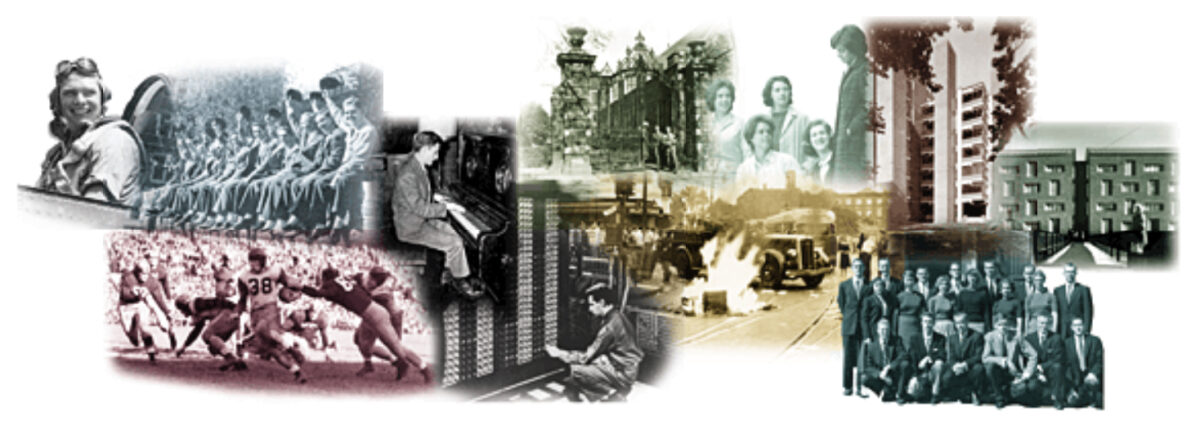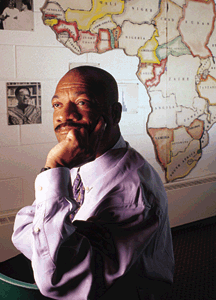Our third Centennial timeline: 1941-1960.
In the 1940s, World War II affects many aspects of University operations and Penn’s football team enjoys a string of winning seasons under Coach George Munger Ed’33. After the war, Penn’s campus expands to accommodate increased enrollment and a new emphasis is placed on research. The formation of the Ivy League marks a new—and at first painful—era in Penn sports.


1941 | On December 7 the Japanese bomb Pearl Harbor. University President Thomas S. Gates W’93 L’96 Hon’31 Gr’46 issues the message that “Times such as these call for strength of character, strength of heart, courage, and steadfastness. Unless called upon by our government, it is also our duty to continue our customary daily tasks. Let us continue to prepare for that which may be expected of us later … ”
1942 | For the fourth straight year, Penn’s football program sets records for fan attendance. An article in the October Gazette reports that the athletic department is busy sorting 336,ooo football ticket requests from alumni as well as from the “general public of Philadelphia, many of whom buy season tickets as unfailingly as they would a suit of clothes.”

1943 | The University opens with “three out of four men in uniform” and with “almost 6o government research projects claiming the attention of the faculty.” The Palestra is transformed into a mess hall for the Army and Navy. Dr. Althea Kratz Hottel Ed’29 Gr’40 Hon’59 becomes the first dean of women.
1944 | Provost George William McClelland becomes Penn’s president. A War Fund Committee is established to deal with the University’s $3oo,ooo deficit. “In recognition of the broader range of interests and responsibilities which the war is bringing to women,” courses in insurance and industry are added to the College of Liberal Arts for Women curriculum. Several hundred returning veterans enroll at Penn for the fall semester under the G.I. Bill of Rights.
1945 | Leonard C. Dill C’28 becomes editor of the Gazette. Musician Bobby Troup W’41, a Mask & Wig standout later famed for hits like Route 66, entertains the Marines in the Pacific. On April 12 U.S. President Franklin Delano Roosevelt dies; members of the University community fill Irvine Auditorium for a memorial service the following day. News of the war’s end on August 14 reaches campus and leads to a rowdy student celebration, quelled by firemen’s hoses and constables’ nightsticks “gently tapped” on a few heads. Radio station WXPN is established to give training to undergraduates “who have in mind a career in radio.” Among them is Harold Prince C’48 Hon’71.
1946 | ENIAC, the 3o-ton progenitor of the modern computer—designed by Engineering faculty John W. Mauchly Hon’60 and J. Presper Eckert EE’41 GEE’43 Hon’64 to aid in the war effort —is dedicated in the Moore School. Football rallies are banned after a Rowbottom-style gathering of 2,000 students before the Penn-Dartmouth game in which trolley tracks were ignited and rotten eggs were thrown at police cars. The ban is lifted, only to lead to another brouhaha involving twice the number of students.

1947 | A disgruntled alumnus requests that his Gazette subscription be cancelled because of the “nauseating” display of “basketball players’ hairy legs” on the cover of one issue of the magazine.

1948 | Harold E. Stassen Hon’48 is named president of the University. He outlines plans to add 35 acres to the University campus, close off certain streets, and construct a new physics building, a new Wharton School building, a new library, and two hospital additions. An undergraduate column in the December issue of the Gazette laments campus inflation: A dorm room with sink and fireplace now costs $120 a term. The price of a hamburger has risen to 20 cents.
1950 | Working in the ancient city of Nippur (Iraq), University archaeologists unearth the oldest known record of a murder trial, chronicled on a clay tablet dating back to 1850 B.C. The Korean War begins.

1952 | Stassen resigns as president. Physicist Gaylord Harnwell Hon’53 succeeds him a year later. Dietrich Hall is dedicated.
1953 | George Munger resigns as Penn’s football coach. The next season, Steve Sebo is named to succeed him. Thomas G. Harris C’49 becomes editor of the Gazette (a role that Dill reclaims in 1957, for another two years).
1954 | The Ivy League is formed; Penn’s football team, hampered by the league’s restrictions—including a ban on spring practice—but still matched up against old rivals like Notre Dame and Penn State, suffers through two winless seasons. Women are admitted to the undergraduate programs of the School of Engineering and Applied Science and the Wharton School. A new physical sciences building (later named David Rittenhouse Laboratories) opens on campus.
1955 | The University embarks on a five-year campus development plan, including 22 major construction projects costing $31 million. Among the planned facilities are men’s and women’s residence halls; the Computer Center; the Faculty Club; and wings for the Moore School, the Fels Institute, the Hospital of the University of Pennsylvania, and the Wharton School.
1956 | Police arrest 24 students at Delta Tau Delta fraternity house for snowball fighting. A student column in the May Gazettecomplained of students being pulled from their beds “whether they were innocent or not.”
1957 | The Soviets launch Sputnik. Meanwhile, a $7 million research project is underway in the School of Medicine’s Department of Pharmacology to determine how to adapt humans for space travel.
1958 | The Gazette merges with The General Magazine and Historical Chronicle, marked by a redesign and new columns and features.
1959 | The Annenberg School for Communication is established. Despite an Ivy League championship for Penn’s football team, Steve Sebo’s coaching contract is allowed to expire at the end of the season. William J. Schramm C’54 G’57 becomes editor of the Gazette.
1960 | The Richards Medical Research Building is dedicated. Designed for “maximum flexibility” by architect Louis Kahn Ar’24 Hon’71, and named by the Encyclopedia Brittanica in its Brittanica Book of the Year as a “significant architectural advance,” the building boasts a circulation system that prevents air taken into the building from mixing with air expelled inside it—thus keeping experiments from contaminating one another. John F. Kennedy narrowly defeats Richard M. Nixon in the Presidential election. Robert M. “Dusty” Rhodes is named editor of the Gazette.




